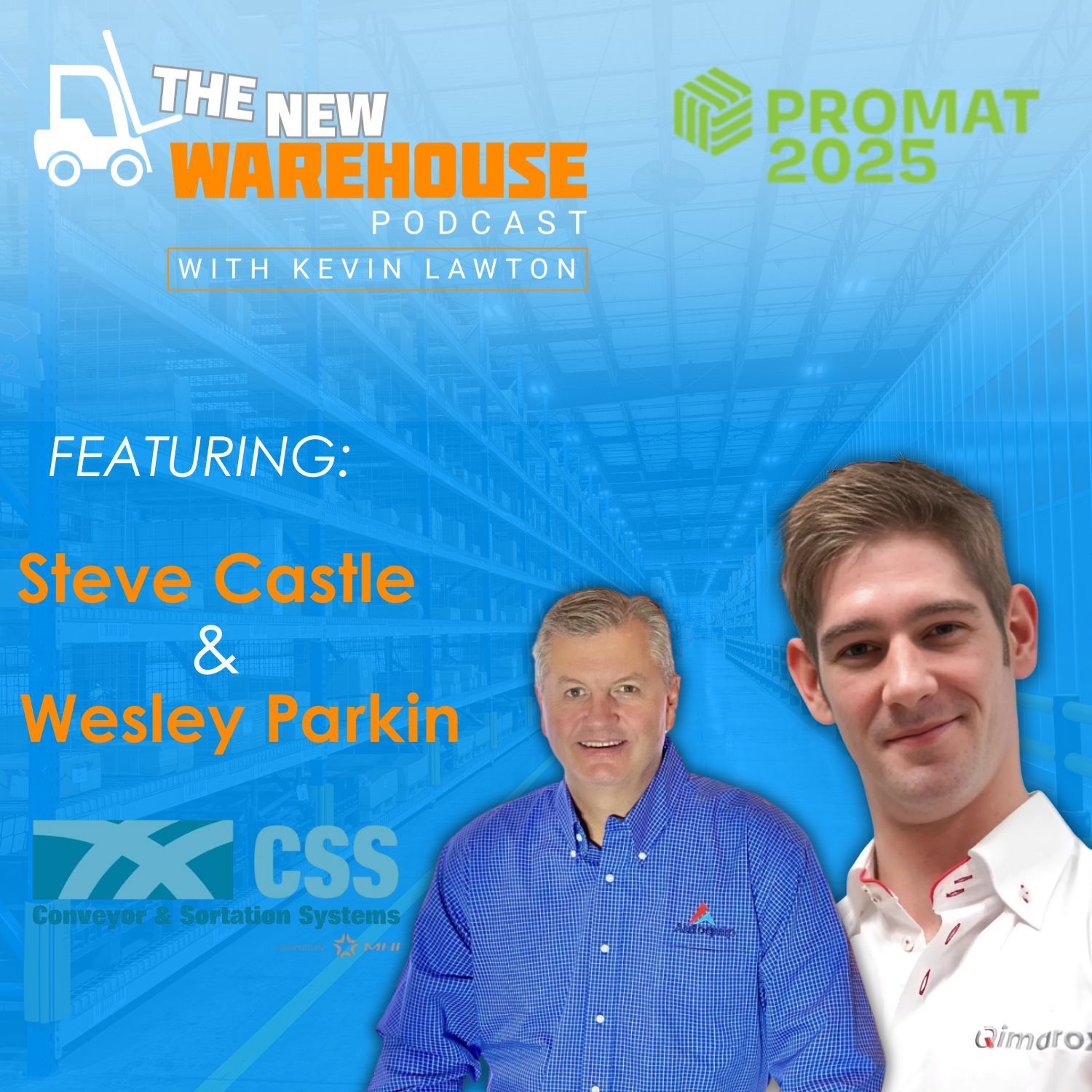
603: MHI’s Conveyor and Sortation Solutions Group on Smarter Vertical Integration
Kevin chats with Wesley Parkin of Qimarox and Steve Castle of Autoquip in this episode of The New Warehouse Podcast, recorded live from ProMat 2025. Representing MHI’s Conveyor and Sortation Solutions (CSS) Industry Group, Wesley and Steve unpack key challenges and emerging solutions in material handling, especially when it comes to moving Autonomous Mobile Robots (AMRs) between facility levels. The conversation dives deep into the CSS Group’s collaborative efforts, the growing need for smarter vertical movement, and how manufacturers and integrators are adapting traditional VRCs (Vertical Reciprocating Conveyors) to meet the precision demands of modern automation.
Collaboration in the Conveyor and Sortation Solutions Group
The CSS Industry Group under MHI isn’t just a gathering of companies—it’s a dynamic ecosystem of manufacturers, integrators, and solution providers committed to advancing the industry through shared knowledge and innovation.
As Steve explains, “There are a number of manufacturers and system integrators… whenever we come together in an industry format, we can network, we can also kind of refer to one another.” This collaboration shines in initiatives like the CSS Group’s referral sharing program. Visitors to booths can scan a QR code and submit their needs to MHI, which then shares the inquiry with group members best equipped to help.
Even among potential competitors, the group fosters cooperation. “None of us have identical product lines… so if we can cross-pollinate and just help be a resource to the customer, it adds value.”
Vertical Movement: The Next Frontier for AMRs
As AMRs become more prevalent, the conversation about how they navigate between levels in a facility is intensifying. Wesley notes this trend is evident on the show floor: “We see more and more need for AGVs going up and down between levels… we try to advise them, show them the benefits, and help them to automate their systems.”
Traditionally, VRCs were designed for manual or forklift-assisted loading. But that’s changing. Steve describes how Autoquip adapted their lifts to accommodate the sensitivity of AMRs: “With an AMR, they’re a lot more sensitive… if it drives on the VRC and there’s a big bump, your load can shift and become unstable.”
Their systems now include load-height sensors and smart controls, enabling better decisions about storage placement. This integration helps maximize density and supports dynamic interactions with WMS platforms. “Once we know the height of the load… they tell us what level to go store it at so that that feedback adds value in the density.”
The ROI Behind Smarter Storage and Flexibility
The shift to vertical integration isn’t just about optimizing space—it’s about unlocking flexibility and long-term ROI. Wesley emphasizes the value of going up instead of out: “The floor space they would need is huge compared to if you’re going to go vertical.”
Steve breaks down how storage density gets a boost from automation that accounts for real-world conditions: “If your pallet is now only 36 inches high, they know that that pallet can be stored on the top floor… It’s just adding value in little ways.”
When comparing AMRs and conveyors, Steve shares a powerful analogy: “Conveyors are like a train… and AMRs are like a delivery van.” Each plays a unique role, but AMRs bring flexibility, space savings, and modularity that many facilities need. Wesley adds, “There are huge benefits in going with the AMR… in terms of redundancy, maintenance, and floor space.”
Key Takeaways on Conveyor and Sortation Solutions
- CSS members actively refer leads to one another, creating a stronger ecosystem for customers.
- AMR-compatible VRCs use load-height sensing to maximize storage density across mezzanine levels.
- Floor space constraints and the push for flexibility are accelerating interest in vertical movement solutions.
- AMRs offer redundancy and modularity not possible with fixed conveyors, making them ideal for evolving layouts.
- Smart controls and early-stage simulation help customers plan automation projects with a clear ROI path.
Listen to the episode below and leave your thoughts in the comments.
Guest Information
For more information on Autoquip, click here.
To connect with Steve Castle on LinkedIn, click here.
For more information on Qimarox, click here.
To connect with Wesley Parkin on LinkedIn, click here.
For more information about conveyor and sortation solutions, check out the podcasts below.
591: Making Digital Transformation in Warehousing Work
MHI Industry Series: The Role of Vertical Reciprocating Conveyors (VRCs) in Modern Warehousing
